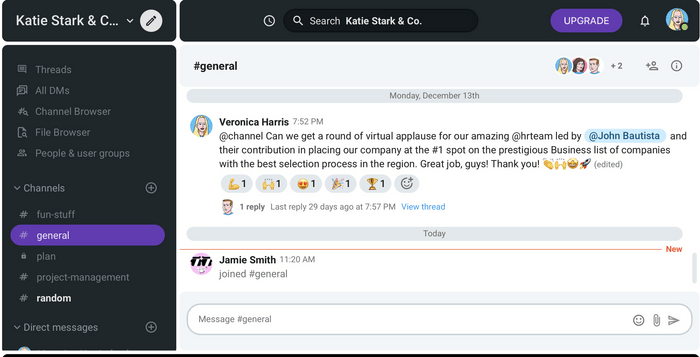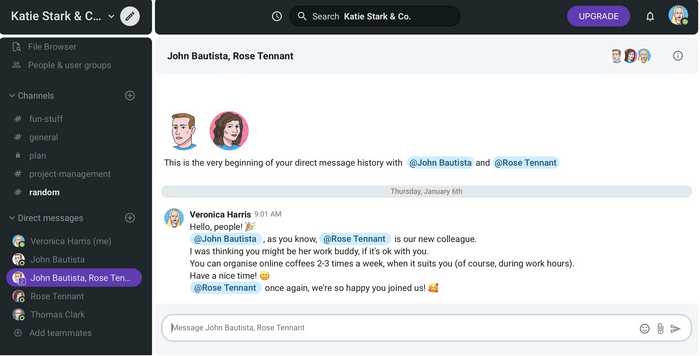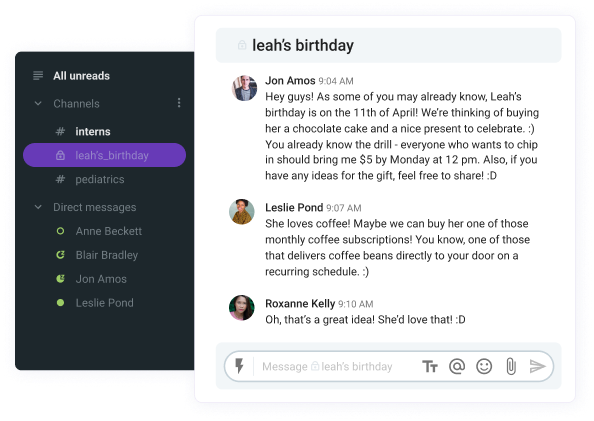Did you ever wonder why you feel so good when your colleague or manager pats you on the back and says: “Good job!”?
Well, it’s because it speaks to our fundamental need to feel appreciated and safe.
It feels good to be recognized for our work, to feel valued.
Sometimes the mere fact that we’ve done a good job isn’t enough for us to feel good about our work. Sometimes we need this pat on the back.
While searching for new ideas and approaches to improve productivity, managers might be overlooking one of the easiest ways to achieve it: employee recognition.
According to a study, 53% of employees want more recognition from their immediate manager. Public recognition not only makes the manager and the employee feel good about themselves. It allows the rest of the coworkers to understand the behaviors that the said company appreciates.
In this blog post, first, we’ll define employee recognition and see some of the examples. Then, we’ll consider its importance. Finally, we’ll give you some ideas on how to provide it.
Without further ado, let’s get started.

Table of Contents
What is employee recognition?
Employee recognition refers to acknowledging your employees for their contributions or achievements.
Also known as social recognition or positive feedback, employee recognition helps employees recognize one another, promotes respectful communication, and improves company culture.
Companies that are considered to be great places to work are usually those companies that recognize their employees’ accomplishments.
Aside from coming from your managers, in an act of downward communication, employee recognition can come from your peers, via so-called lateral communication.
Now that we’ve defined employee recognition, let’s consider some examples of employee recognition.
What are some examples of employee recognition?
There are different types of employee recognition at your disposal. To show your employees that their work hasn’t gone unnoticed, you can use one of the following methods:
- Written praise
- Verbal praise
- Bonuses
- Public recognition
- Private recognition
- Specific rewards
All of these methods can help you provide your employees with due recognition.
So, now that we got familiar with the concept of employee recognition, and illustrated them with examples, let’s see what are the main characteristics needed for employee recognition to be effective.
What are the main characteristics of employee recognition?
Before we dive into the examples of employee recognition, let’s take a look at the main characteristics this positive feedback has to satisfy.
For the employee recognition to be effective, it needs to be:
🔸 Timely — Employee recognition should come promptly, right after the accomplishment, because that’s when it’s most effective.
🔸 Frequent — You don’t have to wait for giant achievements to acknowledge your employees’ achievements. Namely, according to a study by Bersin & Associates, 71% of highly engaged employees come from companies in which their colleagues are recognized at least once a month.
🔸 Specific — When feedback is specific, employees understand how exactly they have contributed to the team with their actions.
🔸 Visible — When you praise your employees publicly, in front of their coworkers, the impact of the recognition magnifies. Aside from that, by giving public acknowledgments to your employees, you show all your workers what values and types of behavior your company nurtures.
🔸 Values-based — Employee recognition based on company values encourages employees to work towards the company vision. Values-based recognition provides a way to connect tangible actions to the company culture.
Since we’ve seen the main characteristics of employee recognition, the question that probably comes to your mind is:
“Why is employee recognition so important?”
The answer to this question lies in the following paragraphs.
Why is employee recognition important?
To better understand the importance of employee recognition, let’s briefly consider Maslow’s hierarchy of needs.
Namely, it is a theory in psychology that deals with human needs, often presented within a pyramid.
From the bottom upwards, the needs are the following:
- physiological needs (e.g. food and clothing),
- safety (e.g. job security),
- needs for love and belonging,
- esteem,
- self-actualization.
Only when the lower-level needs are satisfied can individuals attend to the needs that are higher in the hierarchy.
Our need for recognition is tied to our need for love and belonging, as well as with our need for esteem. If this need is fulfilled, we can accomplish self-actualization.
Aside from that, there is a physiological foundation for the fact that we feel good when we are recognized and acknowledged.
Namely, when our coworkers or managers recognize our efforts and accomplishments, our body releases oxytocin, the chemical that is created when our need for love and belonging is fulfilled.
Now that we’ve seen the psychological and physiological foundations of our need for recognition, let’s consider its effects on the company, as well as its importance.
Employee recognition gives purpose
One of the most important reasons to incorporate employee recognition into your workplace strategy is the fact that it provides purpose.
A study shows that Gen Z is the first generation to prioritize purpose over money.
As a generation that will make up 30% of the workforce by 2030, Zoomers are a force to reckon with.
That’s why you should strive to provide them with the purpose by recognizing their accomplishments.
Our research led us to Irene McConnell, an executive coach and an Official Member of the Forbes Coaches Council, who told us in what ways employee recognition provides employees purpose:

“Recognition plays a key role in motivating employees as it triggers the reward system in their brains. This strategy makes employees feel valued and wanted in their workplace.
Put your star staff members under the spotlight and show them the tremendous contribution their work has made to the growth of the company. It would help foster a culture of development and learning, as employees wouldn’t feel like slaves to the organization.”
Of course, it is one of the steps managers have to take in order to give their employees a sense of purpose.
Your employees should know there is a broader mission in the company they work for.
Employee recognition increases engagement
Who wants an army of clock-watchers as their workforce?
Needless to say, engaged employees are a much better option.
But, what if we tell you that, according to Gallup’s research, only 1 in 3 employees in the US believes that they received recognition for doing good work in the past seven days? It’s safe to assume that these workers don’t feel so engaged in their workplace.
Don’t worry, there is an easy fix to this problem.
Namely, employee recognition has proven to increase employee engagement — which leads us to our next reason why employee recognition is important.
Employee recognition increases productivity
By boosting employee engagement, recognition helps increase productivity.
Research shows that 90% of surveyed employees said that recognition motivates them to work harder, making them more productive.
Employee recognition also improves communication among employees.
In workplaces where employees acknowledge one another’s accomplishments, communication usually flourishes.
Consequently, even productivity is improved, as Workplace communication statistics (2021) shows us that effective communication increases productivity by 25%.
Employee recognition reinforces the company’s core values
Employee recognition allows employees to acknowledge their peers through their behavior and examples of positive performance.
Aside from that, this positive feedback is a valuable tool for leaders to manage and assess how the company’s core values are being lived, which contributes to the company’s success.
In our search for answers to the problem of the importance of employee recognition, we reached out to Dr. George Hanshaw, the director of the eLearning operation and researcher at Purdue University, who shared with us his thoughts on the matter:

“How you recognize employees should match the team culture, which may be different from the overall organizational culture if you work for a larger corporation. Regardless of the organization’s size, recognizing employees connects to an individual’s intrinsic need to feel included, valued, and make a difference. The feelings of inclusion and making a difference to something larger than themselves are significant components for creating a psychologically safe environment.”
Employee recognition nurtures trust
The next item on our list is the fact that employee recognition nurtures trust.
Paulin Larsen Bergloef, a behavioral scientist and the CEO of Swedish startup Whippy, shared with us her views on the matter of employee recognition nurturing trust:

“Recognition strengthens self-esteem and builds trust and loyalty between employees and managers. I believe it is important to recognize employees for their work through giving feedback in small portions often, rather than waiting for year-end reviews. By doing so, we can train and tweak behaviors regularly and create warm, powerful working environments throughout the entire employee life cycle.”
On the other hand, Dr. Kasey Lynn Thompson, an associate professor at Ferris State University, who conducted a qualitative study on employee recognition as part of her Ph.D. research, came to a slightly different conclusion:

“I assumed that as a manager increased levels of employee recognition, employees, in turn, would have increased feelings of trust in that manager. Surprisingly, my research revealed that increased levels of recognition do not positively impact trust. However, the lack of recognition decreases the level of trust an employee has for their manager.”
In other words, even if an increased level of employee recognition doesn’t increase employees’ trust towards their manager, the lack of recognition certainly has detrimental effects on the level of trust.
Ideas on how best to provide employee recognition
Since we’ve established the importance of employee recognition, it’s time to cut to the chase and give you some ideas on how to provide employee recognition.
There are plenty of ways to provide employee recognition. Hence, we’ll divide these ideas into several categories.
Let’s get to it!
Make small gestures
This is probably the easiest way to acknowledge your employees. It doesn’t cost anything but goes a long way.
So, what are some examples of small gestures that would show your employees they are valued and appreciated?
Say thanks more often
“Thanks” is maybe the most underappreciated word in any language.
The famous saying goes: “A beautiful word opens the iron door”.
However, I’m afraid we don’t use it often enough, thereby neglecting its magical ability to open new possibilities for us.
Harvard research shows that a simple “thank you” has a positive impact on our health and happiness.
Let “thanks” be the word you’re going to use more often in the future. We promise you, it can only bring good things.
Give sincere compliments
Sincere compliments are another resource not used enough in our everyday lives. The keyword here is sincere.
Don’t give out generic compliments to your coworkers, but compliment them instead on something specific they have done exceptionally well.
You might be surprised by the effectiveness of this small act of kindness.
Have a company thanks feed
A company “thanks feed” is a useful, unobtrusive way to show your employees that they are valued.
You can use Pumble channels for this purpose.

Give tactical time-outs
If the adage “Time is money” has at least an ounce of truth in it, that would mean that, by allowing your employees to take breaks, you’re almost awarding them with money, right?
All jokes aside, according to research, breaks are important for our productivity and creativity.
So, what are some ways to use time as an incentive and a way of showing your employees they are valued?
Extended breaks
Since we already mentioned that breaks have beneficial effects on our productivity and creativity, why not use them to reward your employees for their hard work?
It can be as easy as extending their lunch break to one hour, instead of thirty minutes.
Or they can choose the time that suits them to clear their heads and maybe breathe in some fresh air, which is also good for their health.
Early finishes or late starts
These tactical time-outs can come in the form of an early finish, or, for all the night owls out there, a late start.
You could reward an employee for finishing their daily quota, or for doing a remarkable job in a short amount of time.
Give free gym time
Employees sometimes get caught in a daily grind and don’t find the time to exercise, which can be detrimental to their overall health.
The data about the general state of health is devastating. According to the World Health Organization, 60-85% of people in the world lead sedentary lifestyles.
This type of award for your workers works on multiple levels – aside from feeling valued and appreciated, they have the opportunity to work on their health.
💡 Pumble pro tip
Speaking of wellness ideas for your employees, check out our in-depth article on wellness ideas for remote employees:
Provide recognition for the entire team 🎖
There’s always an option to provide recognition for the whole team, without singling anyone out. This is especially useful after the successful completion of a project when you want to celebrate with your employees.
Of course, you don’t have to limit yourself. Any occasion that calls for a pat on the back can be an excuse to treat your whole team.
Here’s how you can do it.
Take your employees out to lunch
You could take your employees out to lunch every once in a while. It can be a simple work lunch or a welcome break after a hard task is successfully completed.
Of course, this applies to smaller businesses or teams within bigger companies.
Random surprises
If you feel adventurous, maybe you could organize random surprises for your team members.
For instance, you could get them tickets for theatre or a concert by a band you know they like. These small tokens of appreciation never go unnoticed, and your employees will be grateful for having such a cool manager.
Regular treats every week or month
You can even make this a regular thing.
For example, once a month, you could take your team to movies. (Provided that you manage to agree on a film you’re going to watch.)
Or, once a week you could take a lunch break in a nearby park (if the weather permits).
Possibilities are endless and can be tailored to your employees’ interests and affinities.
Create welcome connections
John Donne was absolutely right when he said that “no man is an island”.
Your employees need other people too, so you can help them make connections with one another. This is particularly important when working from home.
Give new employees a work buddy
The best way to greet and introduce a new employee is to give them a work buddy for the first month of their employment.
If you’re working from home, fear not, we have a solution for you.
You can organize your new and old workers via a messaging platform.

Organize team building/bonding activities
Although they sometimes have a bad reputation, team building and bonding activities are actually a good way to show your employees that you value their contributions to the company.
This is also a nice way to introduce new employees to the rest of your team and give them a chance to bond.
💡 Pumble pro tip
If you’re working from home, we’ve got you covered. Take a look at our article on best virtual team bonding activities for remote teams:
Provide quiet break areas for those who are shy
Not all of your employees like the hustle and bustle of socializing. Some of them, especially if they’re shy, might want some peace and quiet for a few moments during the day, to gather their thoughts and relax.
You can show your shy employees that you acknowledge their needs and value them by providing them with quiet break areas.
There they can find a harbor from the noise of everyday life for at least a few minutes.
An extra tip: For a special treat, provide your employees with a mini zen garden, to help them briefly disconnect from their surroundings.
Celebrate their birthdays
We owe you a little disclaimer at the beginning of this idea: This one is suited just for smaller companies.
A celebration of employees’ birthdays is a thoughtful way of showing the employees that they are valued.
So, here’s what we suggest.
Give your employees cake for birthdays
“Let them eat cake!” Just kidding.
But, seriously, a cake is a nice gesture for your employees on their birthday.
This could be the opportunity for all the coworkers to chip in and show their colleagues that they care about them.

Give your employees a day off for their birthday
If you’re feeling especially generous, maybe you could give your employees a day off for their birthday.
It shows your employees that you care about them and that you appreciate their efforts.
A small gift for birthdays
It’s always a nice idea to give your employees small gifts for their birthday. It doesn’t have to be anything pompous. A gift card in their favorite book store or shop is more than enough.
Another good option is to give them a voucher for a spa or a massage because it shows that you care about their well-being.
Make a practical impact
For those of you who care more about practical tokens of appreciation, we have a few ideas you could try out.
Provide free parking
Employee recognition can come in many forms, one of them being something that bothers each and every employee that comes to work by car.
Yes, that annoying problem with parking in the morning.
You can take the edge off of your employees’ commute by providing them with free parking in the vicinity of your company.
This is one of the subtlest ways of showing you care about your employees.
Support the commute
For those of your employees who don’t drive or are a little bit more ecologically conscious, make sure you provide them with annual tickets for public transportation.
Go green while providing employee recognition!
Provide equipment
Another, maybe a less obvious way of showing your employees working remotely that you value them is providing them with equipment needed for their job.
This shows you have confidence in them, as well as that you’re sensitive to their needs.
Go public
Although private recognition is important for an individual on the receiving end, if you go public, you are using a cost-effective way to motivate all your employees.
Namely, public recognition has a beneficial effect on all your employees, because it motivates them to work harder and be better.
We offer you three different ways to do this.
Social media announcements
Even though we sometimes pretend that we’re above using social media, we all use them, one way or another.
So, why not use their omnipresence to give praise to your employees, in a way that everyone can see it?
Give kudos to your coworkers, while giving the rest of the team a chance to jump on a bandwagon.
Mentions in a monthly newsletter
If you’re using a newsletter, this is also a great opportunity to commend your employees.
That way, your business partners and all the recipients of your newsletter will get the chance to see that you value your employees.
Publish on a company website
You can even use your company’s website to acknowledge the good work your employees do.
It’s a nice ego boost for the employee that’s being praised, as well as an effective motivation for all the others to follow in their footsteps.
Show your employees they are valued with Pumble
Employee recognition, aka positive feedback, is valuable for improving company culture and showing your coworkers you appreciate them.
There are different ways of showing gratitude and appreciation, and a team communication app like Pumble can help you here.
As an all-in-one internal communication software, Pumble can help you provide employee recognition by:
- Encouraging employees to support new hires as work buddies via video calls,
- Sending ‘thank you’ direct messages, and
- Congratulating employees on their achievements in dedicated channels.
It’s nice when you make someone’s day. So, why not harness the power of Pumble to put a smile on your valuable employee’s face the next time they accomplish something great?




